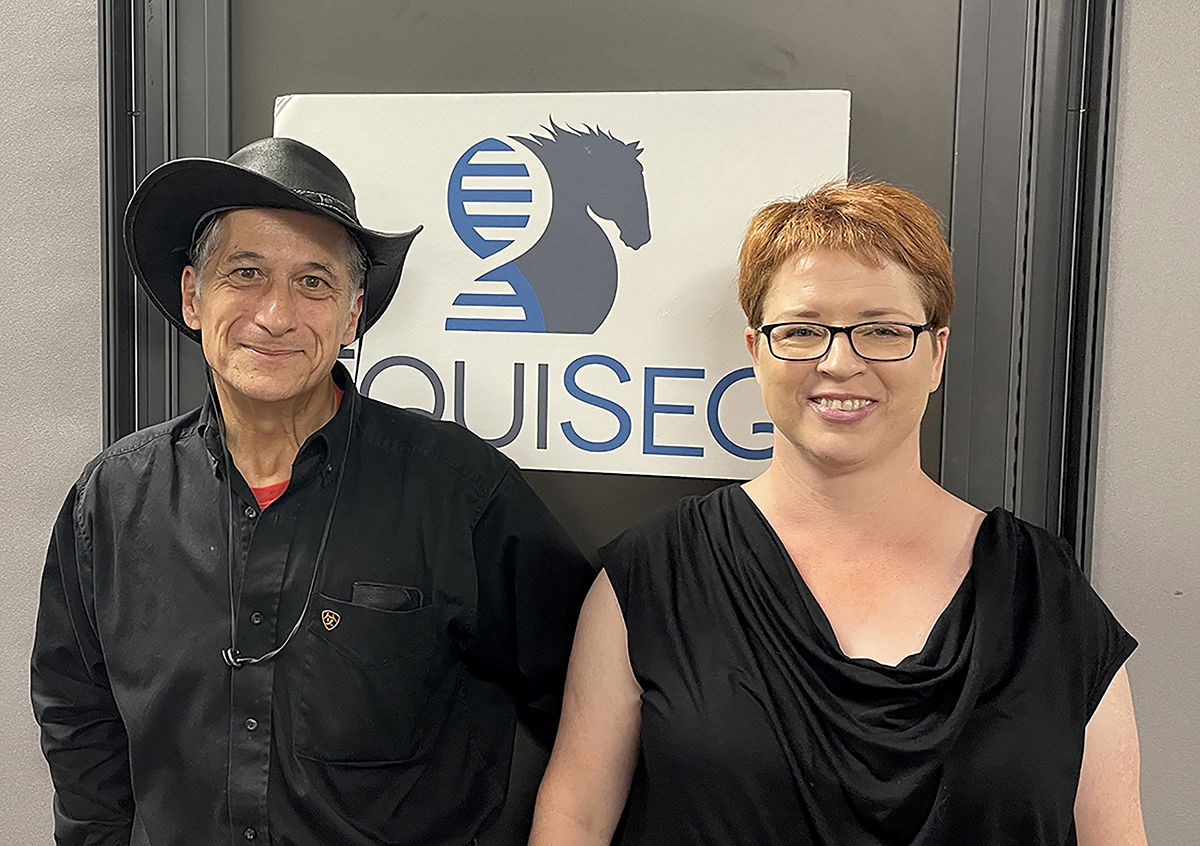Blog
Genetic Linkage of P8 and K1
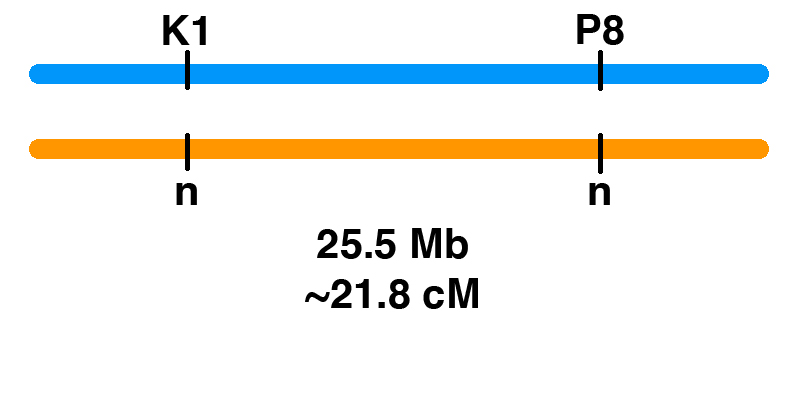
How can you figure out the chances of different genotypes when breeding horses?
Monohybrid Cross
It’s easy for one gene. Let’s say that there is a stallion that has one copy of one of the genetic variants associated with PSSM2, the P2 variant (MYOT-S232P). This stallion is heterozygous (n/P2), meaning that he has one normal copy of the MYOT gene and one copy with the P2 mutation.
If the stallion is bred to a mare that is clear (n/n) for the P2 allele, the Punnett square below shows the odds.
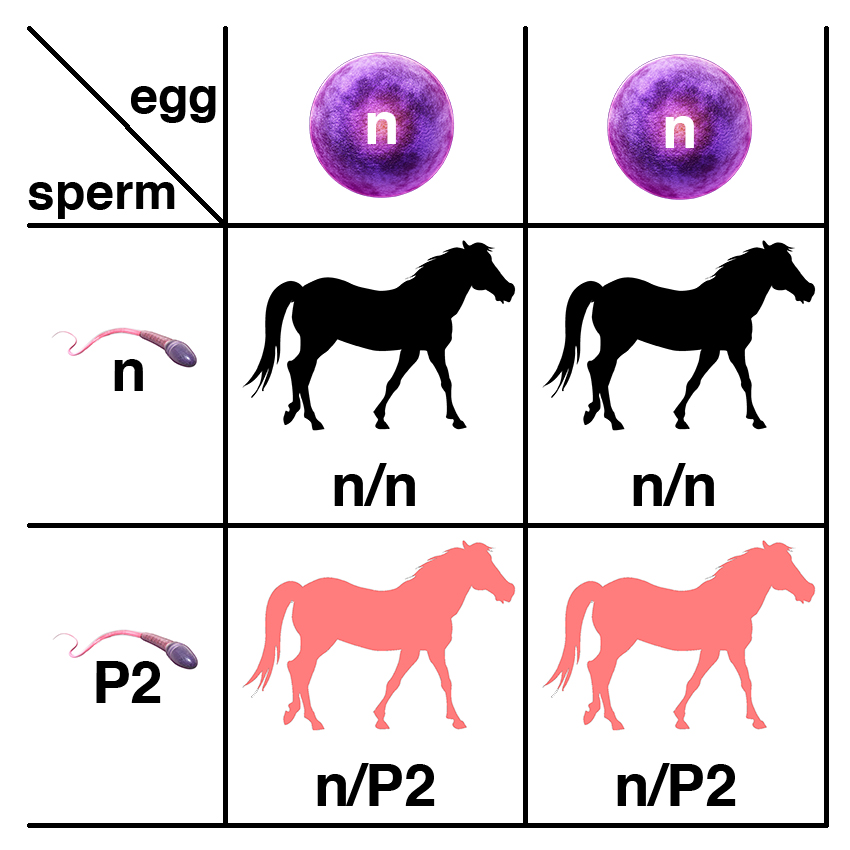
Gametes (sperm and eggs) contain a single copy of each gene in the horse. The stallion produces two kinds of sperm in equal frequency: sperm with P2, and sperm with the normal allele (n). The mare produces eggs with one of the two normal alleles (n).
This means that there is a 50% chance of a foal that is n/P2, and a 50% chance of a foal that is n/n.
Dihybrid Cross
What if we are following two genes? In general, two gene pairs will show independent assortment. This means that the segregation of one pair of alleles into gametes will not influence the segregation of another pair of alleles.
If we tossed two coins at the same time, there are three possible outcomes: two heads, two tails, or one head and one tail (there are two ways to get one head and one tail). The outcome of the toss of one coin does not influence the outcome of the toss of the second coin, so the coin tosses are said to be independent.
What if a stallion heterozygous for GYS1-R309H (P1) and MYOT-S232P (P2) (n/P1 n/P2) is bred to a mare that is clear for both (n/n n/n)? The Punnett square below shows the odds.
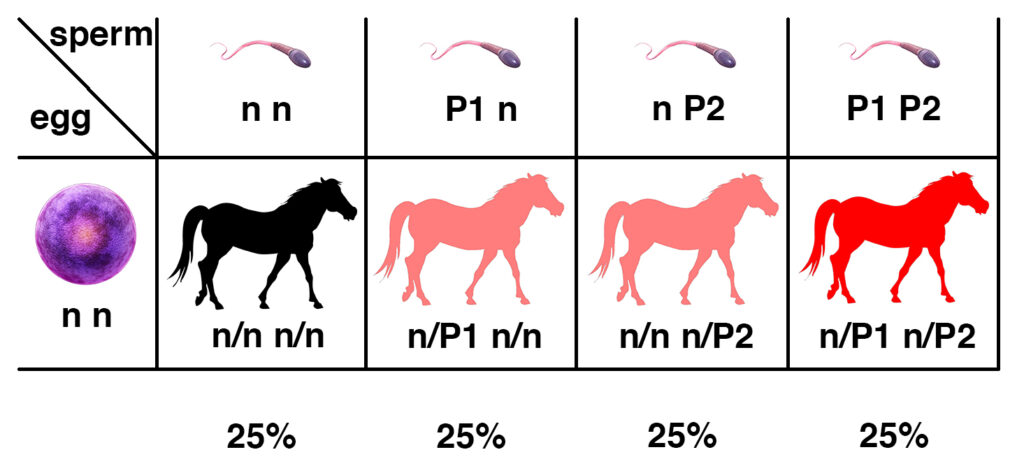
Because each of the four gamete types that the stallion produces are equally likely, the chance for each of the foal genotypes is 25%.
Dihybrid Cross with Linkage
Not all gene pairs show independent assortment. If two genes are close to each other on the same chromosome, the parental types will be more frequent than the nonparental types. What does this mean?
The P8 allele (PYROXD1-D492H) is located on chromosome 6, as is the K1 allele (COL6A3-G2178A). The position of each of these two mutations can be given as base pair coordinates in the EquCab3.0 assembly [1]. P8 is chr6:48,924,749 G/C, and K1 is chr6:23,416,882 C/G. This means that these two mutations are about 25,508,000 base pairs apart (25.5 Megabases or Mb).
The extent of the departure from independent assortment can be measured experimentally, but this has not been done directly for P8 and K1. It can be estimated from published linkage maps for horse [2].
The rate of recombination per base pair varies across the horse genome and differs for any given region among horse breeds [2]. It is possible to estimate the distance between P8 (PYROXD1-D492H) and K1 (COL6A3-G2178A) using the supplemental data in the cited study [2]. For Arabians, the distance is 23.6 cM; for Standardbreds, it is 19.9 cM. For purposes of this blog post, we will use an estimate of 21.8 cM. These breeds were chosen because both P8 and K1 have been found in both breeds.
There are two ways that a horse can be heterozygous for both P8 and K1 (n/P8 n/K1). The horse can inherit P8 from one parent and K1 from the other. In this case, the copy of chromosome 6 inherited from one parent has the P8 allele, while the copy inherited from the other parent has the K1 allele, as shown below.
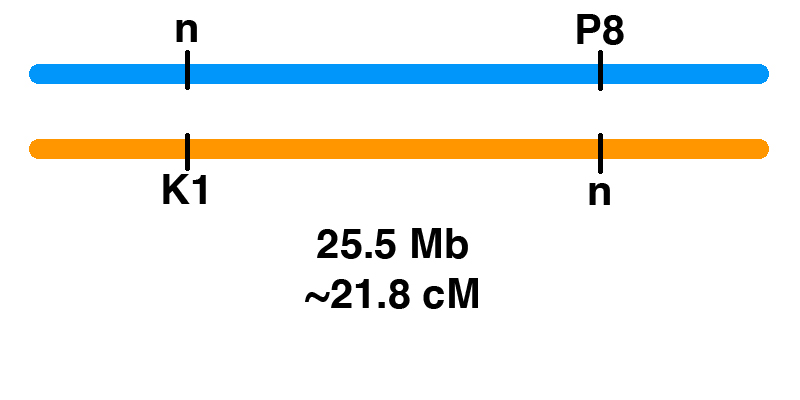
The other way that a horse can be heterozygous for both P8 and K1 (n/P8 n/K1) is to inherit both P8 and K1 from one parent, and the wild-type or normal alleles of both from the other. In this case, the copy of chromosome 6 inherited from one parent will have both P8 and K1, while the copy inherited from the other parent has both normal or wild-type alleles as shown below.

These two different types of n/P8 n/K1 will produce the four gamete types at different frequencies. Parental types (the chromosomes inherited from the parents) will be more frequent than nonparental types resulting from meiotic recombination.
The first type, in which the P8 allele is on one chromosome and the K1 allele is on the other, will produce P8 n and n K1 gametes as parental types, and n n and P8 K1 gametes as nonparental types. If the frequency of recombination between P8 and K1 is 21.8%, as estimated above, the frequency of the four gamete types will be as shown below.
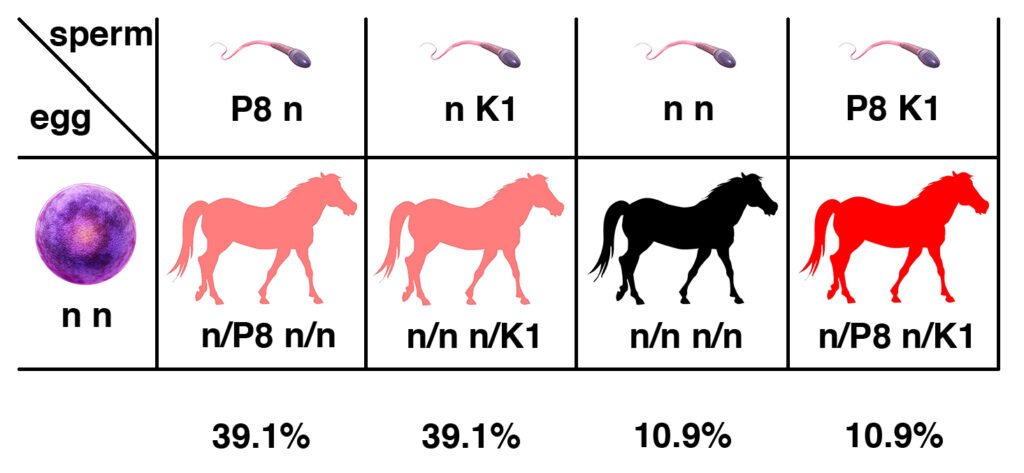
The second type in which both P8 and K1 are on one chromosome and both normal or wild-type alleles are on the other, will produce n n and P8 K1 gametes as parental types, and P8 n and n K1 gametes as nonparental types. If the frequency of recombination between P8 and K1 is 21.8%, as estimated above, the frequency of the four gamete types will be as shown below.
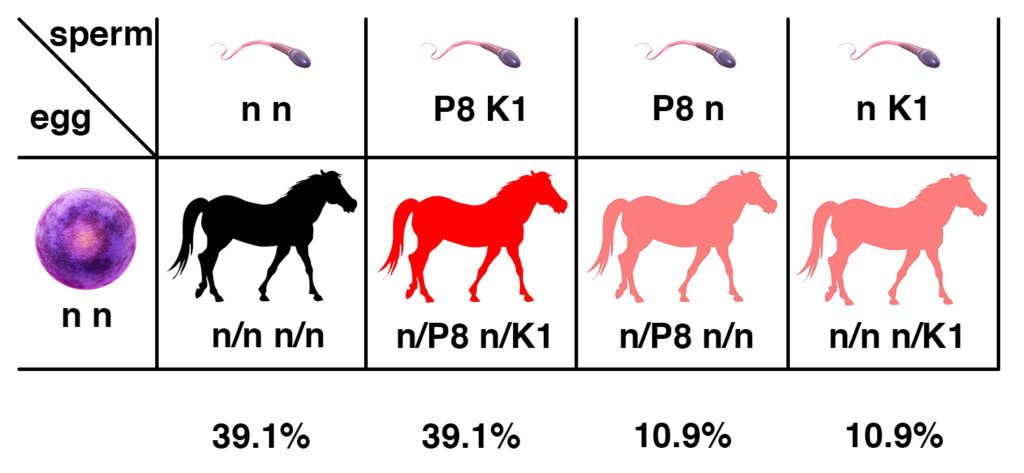
It is not possible to tell from genetic testing of a single horse that is n/P8 n/K1 whether P8 and K1 are on different copies of chromosome 6 (the first case above) or on the same chromosome (the second case above). Genetic testing of one or both parents is necessary.
If a horse that is n/P8 n/K1 has one parent that is n/n n/n, it must have inherited both P8 and K1 from the other parent, as in the second case above.
If a horse that is n/P8 n/K1 has one parent that is n/P8 n/n, n/n n/K1, or n/P8 n/K1, it is necessary to have test results from the other parent to be sure.
What This Means for Horse Breeding
Horses that are n/P8 n/K1 are expected to be more severely affected than horses that are n/P8 n/n or horses that are n/n n/K1.
In this case, if the n/P8 n/K1 horse is highly desirable for breeding, because it represents a line that might be lost or has superior performance, it is best to breed this horse to one that is n/n n/n. From the Punnett square for the first case above, this breeding is likely to produce n/P8 n/n or n/n n/K1. The likelihood of a foal that is n/P8 n/K1 is 10.9%.
A horse that is n/P8 n/K1 that inherited both P8 and K1 from one parent (by testing of parents) is likely to produce n/n n/n and n/P8 n/K1 horses as shown in the second case above. The likelihood of a foal that is n/P8 n/K1 is 39.1% as estimated above. The likelihood of a foal that is n/P8 n/n is 10.9%, as is the likelihood of a foal that is n/n n/K1.
Horses that test as P8/P8 n/K1 or n/P8 K1/K1 definitely have one chromosome that has both the P8 and K1 alleles. We have not seen either genotype in the limited number of horses that we have tested. We have never seen a horse that was P8/P8 K1/K1.
Citations
[1] Kalbfleisch, TS et al. (2018). “Improved reference genome for the domestic horse increases assembly contiguity and composition.” Commun Biol. 1:197. PMID: 30456315.
[2] Beeson, SK et al. (2019). “Exploration of fine-scale recombination rate variation in the domestic horse.” Genome Res. 29(10):1744-1752. PMID: 31434677.
Share this post
From the blog
The latest industry news, interviews, technologies, and resources.
What is PSSM?
Polysaccharide Storage Myopathy (PSSM) is a form of equine exercise intolerance characterized by…
Generatio Scientist Visits EquiSeq
Dr. Melissa Cox, a scientist at Generatio, visited with Chief Scientific Officer Dr….

